
Single-Leg Postures
We begin the single-leg postures by palming the sen lines on the legs to open the energy channels and increase blood circulation. This is followed by a single-leg vinyasa, or yoga flow, that includes several asana-based postures strung together with counterstretches and complementary movements. The single-leg postures are often considered the most dynamic and challenging portion of the massage, as this flowing dance requires much practice and mastery over the working stances. But it is also considered the most fun—so enjoy!
When massaging the sen energy lines we are working directly with an individual’s energetic life force, or prana. This form of pranic healing requires a great deal of mindfulness and subtle perception on the part of the practitioner. We must listen well with our hands, be aware of our recipient’s body mechanics, and watch his or her face for signs of discomfort.
Begin by attuning yourself to the Ayurvedic constitution of your recipient and the natural quality of his or her energy flow. An easy way to do this is to consider the Ayurvedic analogy between the bodily pulse and the animals discussed in chapter 3. You may ask yourself: Does my recipient have quick and irregular vata energy that resembles a snake? Or is it more pitta in nature—strong and bounding like a frog? Or is it slow and graceful, like a kapha swan?
Once you are aware of the quality of your recipient’s energy, follow the sen-line approach that most effectively harmonizes each constitution. Vata individuals benefit from a meditative, slow, and regular rhythm that helps to calm down and neutralize their erratic energy flow. A cooling approach with a moderate pace and pressure is most suitable for pittas. Kapha recipients will benefit from an energizing pace with strong pressure that breaks up physical and mental stagnation. For more details on each of these approaches, refer to chapter 3.
In Thai Yoga Massage there are three sen lines that run along the medial side of the leg and three that run along the lateral side. In this practice we focus on palming Sen Kalathari, which relieves leg fatigue and provides emotional balance.
We begin by working on the inner line of the left leg. Continue with palming the lateral side of the right leg, and then perform all of the single-leg poses on the right leg before walking around to repeat on the other side.
Palming Sen on Medial Side V P K 
Sit in Open Diamond stance alongside the recipient’s right leg. Place your right hand on the inside of the recipient’s left ankle and your left hand above the inside left knee (fig. 10.1).
Gradually palm the leg using Bamboo Rock, simultaneously moving from ankle to knee with your right hand and from knee to upper thigh with your left (fig. 10.2). Palm up and down the leg three times.
After completing this exercise, maintain your position to work on the lateral side of the right leg.
Benefits: Increases blood flow through the legs; removes waste materials through the venous and lymphatic systems; relieves muscular tension in legs and restless leg syndrome.
Vayus activated: Vyana, apana
Ayurvedic tip: Follow the appropriate massage approach for each dosha. For more details on this, see chapter 3.
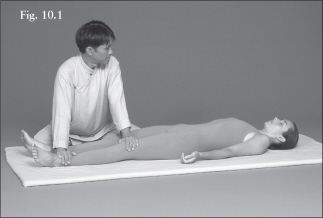
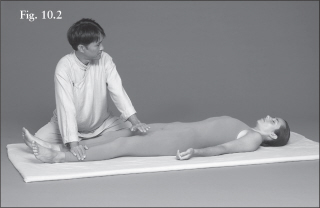
Kneeing Sen on Lateral Side V↑ P↓ K↓↓↓
From Palming Sen on Medial Side, use your right hand to fold the recipient’s right foot inward, exposing the tibialis anterior muscle.
Place your left palm on the recipient’s outer right thigh and move into Open Archer stance so that your right knee is on the tibialis anterior muscle (fig. 10.3).
Rock in gently and apply knee pressure. Move up and down the lower leg twice, working on Sen Kalathari.
To work on the thigh, fold the recipient’s right leg and use your right hand to fix the knee toward the extended left leg. Apply gentle knee pressure up and down the iliotibial band (fig. 10.4).
Benefits: Increases circulation and removes waste materials through the venous and lymphatic systems; relieves muscular tension in legs and restless leg syndrome; internally rotates the hip, releasing tension in the lower leg (the tibialis anterior muscle) and along the iliotibial band, which is often tight.
Precautions: Kneeing is especially effective if you have weak wrists or if you are massaging a person who is much larger than you. It is more powerful than palming, however, so be careful not to apply the full weight of your body. Ask for feedback from your recipient and closely monitor his or her comfort level. Never use your knee to massage on the bones. You should feel free to use palming when necessary, such as when working on slender vatas or on people who are much smaller than you.
Vayus activated: Vyana
Ayurvedic tip: This strong variation of sen-line work is most effective for kaphas.
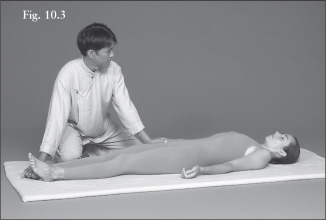
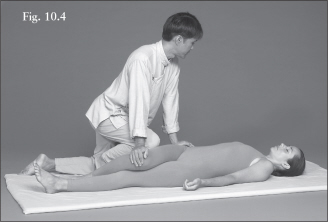
Continue sitting in Open Diamond stance beside the recipient’s right leg. Place one hand under the recipient’s knee and the other under her ankle.
Scoop closer and let the recipient’s leg rest on your lap (fig. 10.5). Use whirlpool rock to rotate the recipient’s knee and hip in a counterclockwise direction (figs. 10.6 and 10.7).
For an extended Thai Yoga Massage session, move on to Nataraj. If you’re performing a basic Thai Yoga Massage, move on to Demi Lotus.
Benefits: Provides greater range of motion and limbers up the hip joint; relieves tension in the hip and leg; increases mobility of the lumbar spine.
Common mistake: Practitioners do not rock with the whole body.
Precaution: Take care not to lift off of the heels as you perform whirlpool rock, as this can overwork your low back.
Vayus activated: Vyana
Ayurvedic tip: Use gentle and slow pacing for vatas; moderate pacing for pittas; swift and rigorous pacing for kaphas.
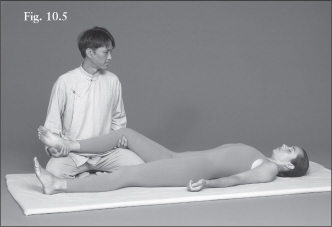
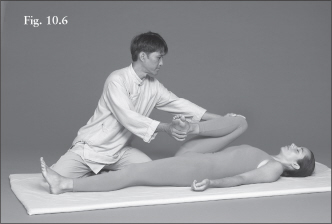
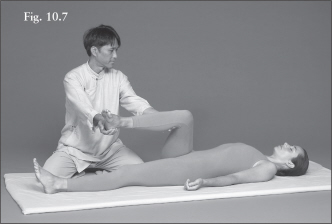
Using the momentum of Helicopter, step your right foot forward over the recipient’s left leg into an extended Warrior stance. Keeping your right hand on the heel, move your left hand to the knee and instruct the recipient to extend her arms out at shoulder height (fig. 10.8). Turning to face the recipient’s head, straighten her leg across her midline (fig. 10.9).
Place your left hand on the recipient’s right thigh and gradually glide her leg down toward your foot. Place your right hand on your right knee and forward rock as you use your left hand to palm up and down the recipient’s upper thigh three times, working along Sen Kalathari (fig. 10.10).
Benefits: Tones the liver, spleen, and pancreas and is good for digestive health; stretches the abductor muscles; compresses and massages the iliotibial band, an area where many people carry tension.
Vayus activated: Vyana, samana
Ayurvedic tip: Twists are generally tridoshic; be sure to apply the appropriate massage approach for each dosha for maximum effectiveness.
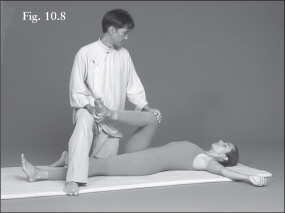
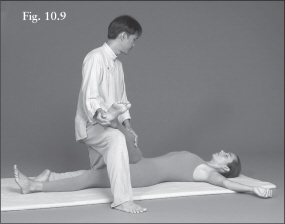
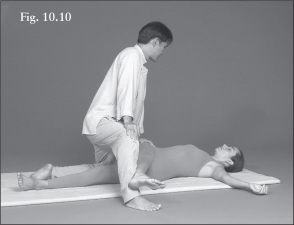
† Stringing Bow V↓ P↓↓ K↓↓↓
From Nataraj, maintain an extended Warrior stance as you glide your left knee behind the recipient’s lower back. Bring your right hand to the recipient’s right instep and your left hand to her right knee. Gently bend the recipient’s leg, stepping back into Open Warrior stance alongside her body (fig. 10.11).
Move your left hand to the recipient’s right hip and gently rotate her right thigh, placing the sole of her right foot on your right hip bone (fig. 10.12).
Move your left hand to the recipient’s right buttock. Apply gradual pressure with your left hand as you lean back onto your left heel; the motion is as if you are stringing a bow. This creates a supported Locust pose (fig. 10.13).
Using your left hand, palm up and down the paravertebral muscles along the right side of the recipient’s spine (fig. 10.14).
Adaptation: For heavy recipients, bring the leg to rest higher up on your thigh, close to your hip.
Benefits: Extends the hip; relieves low back tension and constipation; massages the internal organs.
Precaution: Apply gradual pressure with a mild stretch for those with lower back pain or sciatica.
Vayus activated: Vyana, udana
Ayurvedic tip: This backbend is great for mobilizing kapha. Go easy with limber vata types—even if they are extremely flexible, a full extension is sometimes not what they need. Do not avoid the posture altogether, just proceed mindfully.
From Stringing Bow, come back up into Open Warrior stance on the right side. Interlace your hands underneath the recipient’s right knee. Gently swing her knee upward to bring it perpendicular to your hips (fig. 10.15).
Come into Kneeling Diamond with your knees supporting the recipient’s lower back; wrap both arms around the recipient’s right knee (fig. 10.16). Gradually sit back in the Diamond stance, allowing the recipient’s hips to lift and open (fig. 10.17). Maintain a good stretch for three to five breaths.
Benefits: Opens the hip joint; releases tension in the low back; stretches the adductor muscles; relieves sciatica.
Vayus activated: Vyana
Ayurvedic tip: Vatas will especially love this nurturing hug. Hold this cooling posture longer for pittas, as it releases tension in the hips and mid-abdomen.
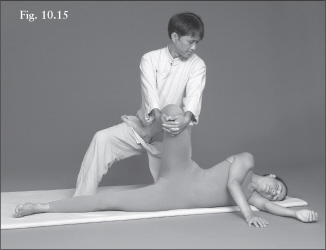
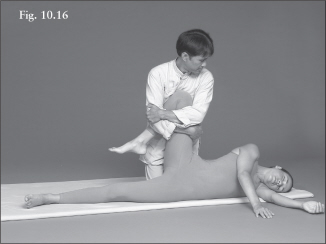
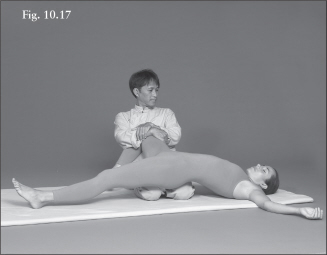
† Apana Release V↓↓↓ P↓↓ K↑
From Hugging Tree, place your left palm on the recipient’s right knee and your right palm on her right instep. Lift up into Kneeling Diamond, allowing the recipient’s hip to return to the mat.
Position your right knee so that it is aligned with the recipient’s left (extended) knee. Lift your left leg up into Open Warrior stance. Place your left hand on the recipient’s right knee and your right hand on the sole of the foot (fig. 10.18).
Fold the recipient’s knee toward her chest and place your left knee at the bottom of her hamstring, just above her right knee. Use your left knee to gradually apply the weight of your body to the back of the recipient’s thigh (fig. 10.19). Work up and down the thigh three times.
Benefits: Relieves constipation and excess gas; tones the internal organs and promotes healthy digestion; compresses and tones the hamstrings.
Precaution: When folding the recipient’s knee toward her chest, occasionally she may feel a pinching sensation near the iliac crest, so make sure not to force the movement. If you sense discomfort, gently move on to the next exercise.
Vayus activated: Apana, samana
Ayurvedic tip: In yoga this posture is called Wind-Relieving pose, as it relieves excess apana vayu. It is particularly good for vata types, but you might want to have some incense and a fan nearby!
Demi Lotus V↓↓ P↓↓↓ K↓
Lift your left knee into Warrior stance. “Wag” your right leg inward in order to face the recipient’s head. Maintain your hand positions and allow the recipient’s knee to fall to the side (fig. 10.20).
Glide forward in Warrior as you push the sole of the recipient’s foot toward her belly. Gradually lean in with your body weight and hold for three to five breaths (fig. 10.21).
Benefits: Stretches the iliotibial tract and the hip flexors; compresses and massages the hamstring muscles; improves mobility of the hip.
Common mistake: Practitioner’s bent knee exceeds his toes, causing an unsteady stance when pushing forward.
Precautions: Do not twist the knee. Avoid this posture in cases of knee injury or strain, hernia, heart disease, and pregnancy.
Vayus activated: Samana
Ayurvedic tip: This bound posture draws energy inward toward the abdomen and has a cooling effect, making it ideal for pittas.
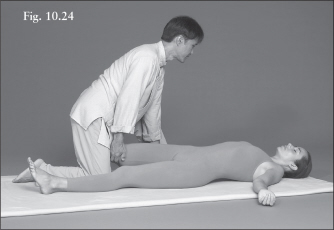
Demi Diamond V↓↓ P↓↓↓ K↓
From Demi Lotus, place your right hand on the recipient’s knee and your left hand, palm out, against the recipient’s ankle (fig. 10.22). Position the recipient’s knee across her body and tuck her foot below her buttock, the dorsal side of the foot facing downward (fig. 10.23).
Step back into Kneeling Diamond and place the recipient’s right kneecap between your thighs (fig. 10.24). Squeeze your legs together to create a stable support for the recipient’s knee.
Fix your right hand on the recipient’s knee. Forward rock as you use your left hand to palm up and down the quadriceps three times (fig. 10.25).
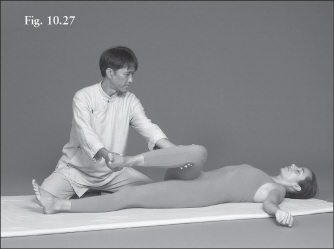
To release, place the recipient’s knee in an upright position (fig. 10.26). Sit in Open Diamond stance at the recipient’s side and apply Helicopter, making clockwise circles, before finally straightening the leg (fig. 10.27).
Repeat all of the single-leg postures on the other side before moving on to the back postures.
Benefits: Stretches the quadriceps muscles; tones the abdomen; aids digestion and absorption.
Precautions: Avoid in cases of knee injury or strain, as this can be a very powerful stretch. Move gradually and ask for feedback to assess your recipient’s comfort level.
Vayus activated: Samana, apana
Ayurvedic tip: For vatas, use your thighs as a support to avoid lowering the recipient’s knee all the way to the mat. For vatas, remember to encourage building strength over flexibility.
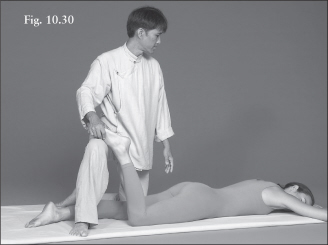
Transitional Flow
In preparation for the back postures, you will now gently flip the recipient to prone using the following technique.
Ask the recipient to raise her arms overhead, extended on the mat. Use whirlpool rock to swing the recipient’s knee across the midline as you step into Warrior stance, your front foot over her outside leg (fig. 10.28). With the momentum of the whirlpool rock, gently swing the recipient into a prone position (figs. 10.29 and 10.30).